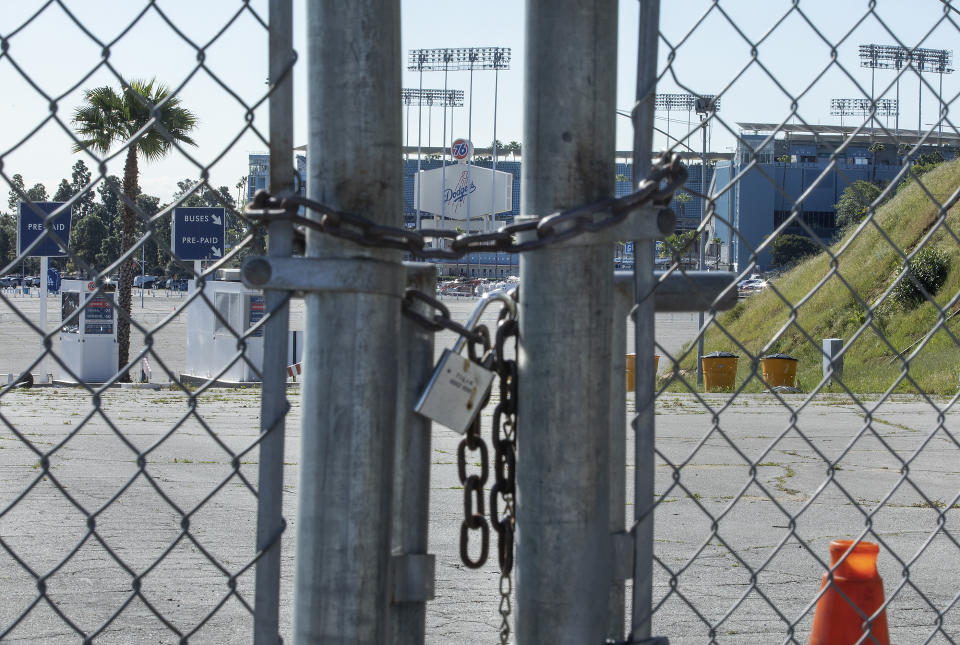Suddenly baseball in 2020 seems very unlikely as coronavirus uptick hits teams
Maybe you felt that way all along. Stalwart in your pandemic pessimism that will probably prove to be realism, you didn’t let yourself buy into the implicit hope of warm weather or get distracted by the labor strife that threatens to derail Major League Baseball if the disease doesn’t. But for me, it was a confluence of events today that served to highlight how precarious a hypothetical season always was, and how carelessly the country has squandered the chance to contain the coronavirus as quickly as expert understanding would allow.
First, a report that eight people at the Philadelphia Phillies facility in Clearwater, Florida — five players and three staffers — along with many of their family members tested positive for COVID-19. The facility was shut down indefinitely. Then, a Toronto Blue Jays player at the nearby Dunedin camp showed symptoms and their fields were closed as well. One of just a handful of Houston Astros players training in West Palm Beach tested positive.
The Wall Street Journal reported that 11 players from seven teams’ 40-man rosters have tested positive since the start of June. More spring training facilities started closing; more cases started popping up in other sports.
It’s not athletes or athletics that are the issue; it’s policymakers in states that are opening up prematurely and the people who think precautionary measures are a political statement. As troubling as the handful of positive tests around MLB are, they’re the natural byproduct of training in a state that has set a record high for new confirmed cases nearly every day this week. And Florida is just one of 10 states “currently reporting its highest seven-day average of new coronavirus cases per day since the crisis began,” according to a CNN report.

As of Friday, the United States had over 2.2 million confirmed cases of COVID-19 and close to 119,000 deaths. There were 26,875 new cases around the country today alone. It’s the worst single day since June 5. Before that, you have to go back to mid-May to find new daily case totals over 26,000. The pandemic isn’t over — it isn’t even on the downswing.
“We never got off this curve, we’re still on the same curve,” Dr. Vivian Towe, an epidemiologist at the Patient-Centered Outcomes Research Institute, said about the so-called second wave that was supposed to hit once the weather turned cooler again. “That might not be true for every place, but people are reading that we’re in a major dip, and then we’re looking for something to come up — when honestly, in a lot of places, there never was a dip.”
I reached out to experts earlier this week to try to understand what it would — or should — take to cancel a baseball season once it was already underway. It’s an issue that’s pertinent not just to public safety, but also to the strained negotiations between MLB and the MLBPA. How far into the fall baseball can be played and how comfortable either side should be banking on the substantial revenue of the postseason are critical questions that go toward accurately evaluating various proposals. It seemed like baseball needed to know if and when — or at least why — it might stop before it could start.
Now, I’m not so sure it will be able to start at all.
Of course, baseball will take strenuous precautions. I don’t doubt their best intentions or efforts. Before the whiplash-inducing weeks of bickering over economics, we were introduced to a health and safety proposal that was 67 pages at one point and remains under careful construction.
But as Dr. Towe explained, being able to mitigate the risk at stadiums is such a small piece of keeping all the players, team employees, support staff, their families and surrounding communities safe while playing baseball during a pandemic.
“Because the players are really living in a context beyond the game,” she said. “And that’s where the source of the risk is.”
That risk was always going to manifest as infected players or personnel. The experts understood this, and frankly, so does MLB. The health and safety protocols include contingency plans for positive tests because the league knew it wouldn’t get through the season without one. But what about 11? At least. In less than a month.
Suddenly, it feels like we’re playing whack-a-mole with a potentially deadly disease, trying to contain outbreaks retroactively and that’s before adding the complication of having to get a game in nearly every day.
“If we knew everything we needed to know about the disease,” said University of Washington epidemiologist Dr. Steve Mooney, “we’d already be making the right decisions.”
The prevailing plan for months now has been to have teams play in their (empty) home stadiums, traveling only within their regions. Now, as it becomes increasingly clear how variable levels of local laxness contribute to new spikes, the league is reportedly considering implementing a bubble along the lines of the NBA in Walt Disney World. Baseball’s bubble would be in Southern California, where confirmed cases are still rising but they have a handful of nice stadiums and a new policy mandating masks be worn in public spaces.
But honestly, even if the number of games wasn’t so fraught and the relationship between the league and the union wasn’t so frayed, it’s getting harder to imagine such a plan coming together in time to play a meaningful season. And at this rate, I’m not sure it would be safe if it did.
More from Yahoo Sports:
